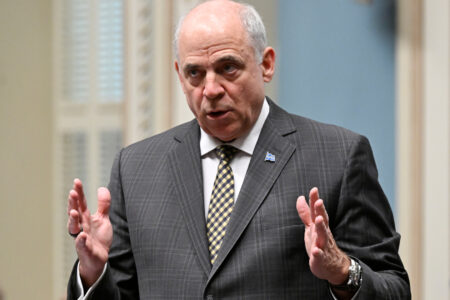
Discussions about Canada’s innovation performance have followed a familiar narrative for decades. We are among the world’s leading countries for educational attainment and we produce science and ideas on pace with advanced economic peers. But our productivity and economic growth have stalled due to weak innovation among Canadian firms. Business investment in research and development (R&D) and technology adoption are well below the OECD average. Our “low innovation equilibrium” is deep and persistent.
Past policies have failed to address these problems.
Sometimes, we focus on the wrong aspect of the problem altogether. The Canada Foundation for Innovation, as well as the Canada research chairs and Canada excellence research chairs programs, have strengthened our research capacity and our scientific base. However, they have not addressed the critical challenge of boosting our performance on innovation.
Sometimes, we focus on the right problems with the wrong solutions. Since the 1980s, Canada has provided generous tax credits through the scientific research and experimental development (SR&ED) program. But as business R&D continues to fall in Canada – while other jurisdictions with direct supports for business innovation are seeing more R&D activity – Canada has failed to adjust the balance between its indirect tax support and direct program spending.
With the 2022 federal budget, however, the Trudeau government has embraced a clearer understanding of the nature of Canada’s innovation challenge, focusing on business innovation rather than inputs to the R&D process. As well, it has engaged industry with a suite of innovation organizations – rather than ill-focused and/or temporary programs – that are focused on long-term challenges and a willingness to experiment.
In the past, efforts to remedy these deficiencies have been plagued by two forms of myopia. First, there has been a tendency to focus on boutique innovation programs rather than a coherent and integrated policy mix that can stimulate changes in companies’ behavior. Second, we have seen a stubborn commitment to increasing R&D inputs rather than a process of continuous co-experimentation with industry and a willingness to learn from past failures and successes. Three initiatives announced in the budget reflect a constructive shift towards the more independent, experimental and business-focused innovation policy that Canada needs.
From innovation superclusters to global innovation clusters
The innovation superclusters initiative, launched in 2018, was a confused piece of public policy from the outset. Initiated as the fulfillment of the Liberal’s 2015 election promise to support clusters, the program was designed as an industry-led research program similar in some respects to the Catapult Network centres in the U.K. and the Manufacturing USA institutes created by the Obama administration in the United States.
If there was a cluster aspect, it was at best a minor add-on to a program primarily focused on funding industry-led research projects, as it effectively turned each of the superclusters into a mini granting agency. Even more significantly, the program followed the age-old Canadian approach of spreading the benefits evenly across the country. No one familiar with the long history of Canadian innovation policy was surprised that the winning bids were evenly allocated across the five major regions of the country.
A shift to the global innovation clusters in the 2022 budget reflects a tactic rarely found in Canadian innovation policy – a willingness to revisit the initial premises underlying a program to put it on a more competitive basis.
In a critical sense, this signals a shift to a more experimental governance approach. It incorporates a willingness to critically evaluate past successes and failures, and –– rather than kill off the entire program –– modify its design to improve effectiveness in enhancing the innovative capabilities of Canadian firms.
If the new funding is directed to the most effective clusters in supporting cutting-edge research that enhances Canadian firms’ global competitiveness, it will mark a noteworthy turning point in Canadian innovation policy. Whether this happens will depend on the ability of federal program managers to make tough decisions and the willingness of the innovation clusters themselves to direct their funding resources to the most impactful firms and projects.
Canadian Innovation and Investment Agency
The adaptation and stabilization of the superclusters program has been flanked the creation of new innovation agencies. The 2022 budget sensibly looks for inspiration from Finland and Israel, historically low-technology economies which were transformed into innovation powerhouses. This was through the use of independent agencies – Tekes in Finland (now Business Finland) and the Office of the Chief Scientist (OCS) in Israel (now the Israeli Innovation Authority) – that upgraded private sector R&D capabilities by incentivizing firms to collaborate with other enterprises, universities and applied research institutes.
To bring private sector actors to the table, Tekes and the OCS relied on direct, targeted instruments, most notably grants. Critics will doubtless fret over the government’s role in picking winners and there is a real risk here.
But the dirty secret in innovation policy is that all programs, no matter how neutral or laissez-faire, attempt to pick winners. SR&ED is no exception, favouring large (often foreign) enterprises with established product lines over the small- and medium-sized firms which have yet to achieve profitability or that lack R&D capabilities. Our reliance on basic research –– which also favours large, incumbent firms with high absorptive capacity –– has compounded the problem.
Using direct and targeted instruments is a more effective strategy if the goal is to develop new innovation capabilities and not merely subsidize pre-existing ones. This can be particularly effective when administered by an independent agency with the flexibility to target smaller firms, new sectors and overlooked industries. Indeed, when Sweden realized that tax incentives and investments in basic research were favouring large, century-old, incumbent firms, it introduced a new agency, VINNOVA, modeled after Tekes.
Political independence gives agencies the flexibility to engage in the entrepreneurial process of discovery and experimentation that underpins effective innovation policy. Agencies must have the ability to place multiple bets, drop unprofitable ones, and retire or offload successful ones to make space for new initiatives. By delegating experimentation to a dedicated organizational structure –– rather than relying on a carousel of cleverly named, temporary innovation schemes –– the 2022 budget promises to create the continuity in personnel and procedures which can improve clarity and accessibility.
Canada Growth Fund
The Canada Growth Fund is the biggest, but also the vaguest and most controversial, innovation initiative in this year’s budget. With an initial capitalization of $15 billion over five years, the fund is expected to attract private sector investment to “help meet important national economic policy goals.” This includes meeting Canada’s climate change commitments; diversifying the economy and bolstering exports by investing in low-carbon industries and new technologies; and restructuring supply chains in “areas important to Canada’s future prosperity – including our natural resources sector.”
The government is looking for “expert advice from within Canada and abroad” before putting together the final structure for the fund. This makes it hard to assess its potential contribution to addressing Canada’s innovation challenge.
The budget notes that this fund will operate at arms-length from the government, which should give it room to make decisions and investments with some insulation from day-to-day political winds – a design feature that has been important to successful innovation agencies in other jurisdictions.
The focus on innovation to address key issues such as climate change, economic diversification and supply chain security is constructive. As well, baking independence into its rough architecture is promising. To be sure, skeptics worry that it could meet the same fate as the troubled initiative on which it is modelled – the Canada Infrastructure Bank (CIB).
This is a fair concern. In its first few years, the CIB was slow in spending its $35 billion endowment and in attracting private sector partners, leading industry observers and some opposition politicians to suggest it be shut down.
With a smaller (albeit still significant) initial budget, political independence and a tight focus, the Canada Growth Fund will be in a better position to succeed, provided the final design and operation maintain the spirit and structure of effective innovation agencies.
Independence, experimentation and adaptation
This budget alone does not fix all of Canada’s innovation problems.
Some elements will prove more successful than others. There are political and administrative vulnerabilities in the global innovation cluster program and the Canada Growth Fund ranging from political interference to the risk of making a string of bad bets.
Meanwhile, even the most successful organizations, including Tekes and the Israeli OCS, have needed to adapt. That is the nature of innovation policy. The critical factor in determining its ultimate success will be the ability of the new agencies to operate in an experimental fashion that critically assesses their performance and adjusts strategy in an ongoing, iterative fashion. If this budget creates a firmer and more consistent foundation for experimentation, it represents a valuable step in the right direction.













